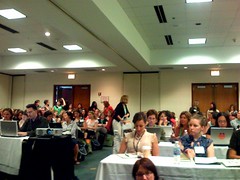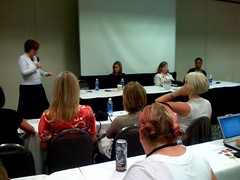 The Art of Storytelling
The Art of Storytelling
Session description: "There have been many
calls for a session about the art of writing itself…how to improve
your writing, how to find your unique voice, etc. This session covers
narrative prose, and the blog as a platform for narrative prose
specifically. In a blogging world of 140 character posts on Twitter and
link posts posing as "content", is there a place for stories? Author,
blogger and screenwriter Claire Fontaine talks with other bloggers Birdie Jaworski and Ree from Confessions of a Pioneer Woman, about why they still find time to write intriguing beginnings, gripping middles and satisfying ends."
Audience: We’re trying to build a collective story by way of interviewing a number of people. What suggestions would you have?
Birdie: I live in a small town in New Mexico. The families in my area have an incredibly rich history, but no one ever tells them. I went to the library, found old photographs of the community, and now I am showing the elder members of the community the photographs, and asked them to tell me about that place. If you show people something that can be a visual cue, it can bring back a flood of memory. It’s been fascinating.
Claire: Asking the right questions is probably key. If you can ask the right questions, it can tease those stories out.
A lot of interesting conversation of "telling stories" versus "blogging" or other similar forms. Stories are just that … beginnings, middles, and ends. Characters. Narrative arc. Stories are a very different creature than an episodic blog post that is not of any particular "form."
Audience: Which are the stories that I want to keep close, and just for my family and friends? Which ones do you put out there into the world?
Claire: I just published a memoir. For me, telling "risky" or "scary" stories from your past frees yourself. The stuff that people respond to are the stories that we were originally afraid to publish.
Claire asks herself three things every time she writes: "Is it true? Is it clear? Is it beautiful?" But she also explicitly does NOT think about the "reader," as she would lose her "inner conversation" that creates her stories. The only fact-checking is "am I telling the truth from within?"
Birdie uses contrast as a mechanism. For example, she writes about a man in her town, and compares him to herself. In doing so, she brings out more of what she is about and, at the end of the story, at which she and the subject are equal, but different.
Audience: What about "creative nonfiction," (yes, I know I’m using the term wrong) where I put two things together that were each true, but didn’t happen at the same time? Or I leave out the middle of the story, because the beginning and end were the most interesting. What’s the right way to do this?
Panel: You *definitely* need to disclose that. Even putting the phrase "based on a true story" will help to prevent you from getting into the trouble. Or, if you’re not sure of a fact, preface it with "I think" or "in my opinion"…don’t state something as fact if that’s not the case.
Claire says "every story is an unanswered question." And don’t answer that question until the end. That mystery is the key.






 Just arrived in Chicago and am heading into the first session at BlogHer 2007. Will be liveblogging some sessions later; other folks are
Just arrived in Chicago and am heading into the first session at BlogHer 2007. Will be liveblogging some sessions later; other folks are 

 “Still, I had to cringe at the campy, off-target Microsoft presentation during the welcome session just a few minutes ago.
“Still, I had to cringe at the campy, off-target Microsoft presentation during the welcome session just a few minutes ago.